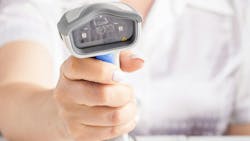In 2018, I wrote about a successful demonstration program in the U.K. that documented the value of using standardized GS1 barcodes to track inventory from the point of manufacture to the point of use. At the time, I questioned why more National Health Service (NHS) trusts had not adopted the program, given that all six demonstration sites achieved better operational efficiency, cost savings, and enhanced patient safety measures. The program is finally getting traction, even without government funding or mandates, and it provides lessons on the value of standards, barcode scanning, and going beyond what is required or funded.
What is Scan4Safety?
Under the Scan4Safety (S4S) program, healthcare delivery systems (called trusts in the U.K.) employ barcode scanners to capture data on patients and the products used in their care. In 2016, the U.K. government provided seed funding to six NHS trusts to measure how adopting and scanning GS1 barcodes could “enhance patient safety, improve operational efficiency, and reduce costs.” The results were overwhelmingly positive, with the trusts freeing up clinician time to spend on patient care, improving recall response time and costs, lowering costs through product standardization, and reducing inventory holding costs.
What is the current state of the program?
Despite the lack of funding or mandates, an increasing number of NHS trusts are implementing S4S, and NHS England is prioritizing the program to improve the use of supply chain data as a strategic asset.
Like its peers, East Lancashire Hospitals NHS Trust launched S4S in the operating theater, where it scans both implants and consumables at the point of consumption. Product replenishment is automated based on what was used; product picking takes minutes, not hours; and recalls are handled in seconds vs. days or weeks. As supply chain takes over tasks previously handled by clinicians, clinicians have received 250 weeks of time back to spend on patient care over two years. Finance enjoys higher stock values on the balance sheet, while inventory holding costs are down. The success of the initial rollout has enabled the integrated care system to have a common inventory management strategy, with opportunities to share stock and standardize processes across all locations where S4S is implemented.
At Manchester University NHS Foundation Trust, S4S has improved how inventory is managed. By educating clinical teams, the trust has reduced incidences of products being opened and not used or faulty products being thrown away vs. returned to supply chain and the manufacturer. The trust has seen measurable savings by increasing compliance with standardization initiatives and reducing the number of times the Trust is charged for products that have not been used.
Both trusts have linked their respective inventory management and electronic patient record systems, allowing for real-time data capture on the products used in patient care. At these and other trusts implementing S4S, the key to the accuracy of this data has been access to a product catalog that employs the GS1 Global Trade Item Number (GTIN) to identify products. GTINs are among the codes compliant with unique device identification (UDI) rules. While UDI is not yet a requirement in the UK, there is strong support within the NHS and among the Scan4Safety trusts for the adoption of GS1 standards, which, like in the U.S., are used to identify products and locations. In the UK, there is also a GS1 standard to identify patients, which combined with the other standards increases visibility into what products are used on which patients and where. This, in turn, supports an NHS objective to understand the role of products, particularly high-risk medical devices, in improving outcomes. The success of S4S offers an important lesson to health systems in the US and beyond that, even without government funding or regulatory requirements, there is a strong business case for investing in inventory management with barcode scanning and the use of standardized identifiers.
About the Author

Karen Conway
CEO, Value Works
Karen Conway, CEO, ValueWorks
Karen Conway applies her knowledge of supply chain operations and systems thinking to align data and processes to improve health outcomes and the performance of organizations upon which an effective healthcare system depends. After retiring in 2024 from GHX, where she served as Vice President of Healthcare Value, Conway established ValueWorks to advance the role of supply chain to achieve a value-based healthcare system that optimizes the cost and quality of care, while improving both equity and sustainability in care delivery. Conway is former national chair of AHRMM, the supply chain association for the American Hospital Association, and an honorary member of the Health Care Supplies Association in the UK.
